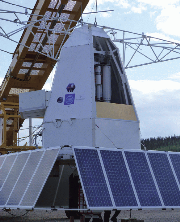 Correctly installed, a bearing will meet the application demands. R.A.Rodriguez guides us through how to install large diameter bearings, then looks into one application where angular contact bearings met some very demanding application requirements
Correctly installed, a bearing will meet the application demands. R.A.Rodriguez guides us through how to install large diameter bearings, then looks into one application where angular contact bearings met some very demanding application requirements
When it comes to installing bearings with a large diameter on rotating equipment or for oscillating applications, things can go wrong. There are, however, steps that can be taken to help prevent many of them.
For a start, installation should be done in a clean, dry area, with mounting surfaces and housing pilots unpainted and wiped clean; and the mating surfaces should be inspected, with nicks or burrs removed. Now, the manufacturer’s protective wrapping can be removed and the bearing hoisted by the use of eye bolts in the mounting holes, or by non-metallic slings.
The bearing should be mounted so the loading plug is in an area of minimum load. If the plug is in the rotating race, it should be located 90° from the maximum moment loading zone. If the plug is in the stationary ring, its location will depend on the position of the minimum load zone relative to the stationary part of the machine.
The manufacturer’s recommendations for size and diameter of fasteners should be followed. Usually, SAE grade 5 bolts are specified, but in some cases higher strength bolts may be necessary. An increase to Grade 8 bolts will usually increase proof load by 40% and therefore decrease the number of bolts and bolt holes required. However, it is critical that the proper torque is applied to each bolt during installation. Hardened flat washers or preload-indicating washers should be used to distribute the bolt load under the bolt head and prevent crushing of the area surrounding the bolt hole.
Care must be taken when mounting bearings with weld hands, to ensure that the welding does not distort the bearing when cool. Changes in bearing clearance and out-of-roundness will affect performance and life. It is good practice to tack the bearing down every six inches along the weld band before the final weld head is laid.
After mounting, the bearing should be checked for torque level and evenness of torque during rotation.
With many bearings shipped already lubricated, these must remain in their shipping container and stored horizontally until ready for installation. Long-term storage may require re-greasing of the bearing before installation.
Then, to maximise the life of the bearing, regular lubrication and bolt torque checks should be carried out.
Meeting application demands
Installed correctly, a properly specified bearing will meet the application demands. Kaydon, in fact, offers a wide variety of bearings, which are available in the UK from R.A.Rodriguez. According to the company, there is a Kaydon bearing available to suit every load requirement, as well as special applications including those that are resistant to corrosion, high temperatures and chemicals, as well as those for nuclear and clean room applications. One example available is the angular contact bearing.
Such bearings are a key component in the PoGOLite – the Polarized, Gamma-ray Observer, designed to study high energy light (x-rays) emitted by heavenly bodies such as neutron stars, pulsars and black hole systems.
The telescope will be lifted into space by a helium filled balloon so that it can travel on stratospheric winds across Sweden, Norway, Iceland, Greenland, Canada and Russia, returning to Sweden 20 days later. As a result, keeping the payload to a minimum without compromising performance has been a key issue in the design of the PoGOLite altitude control system (ACS), which needs to reach the greatest altitude possible. Swedish company DST was responsible for this element, so contacted R.A.Rodriguez for a solution.
To meet requirements, DST specified 50mm and 70mm Kaydon angular contact bearings to allow for accurate control of the elevation angle of the telescope. The elevation bearings therefore carry the full mass (700 kg) of the telescope and are able to survive the 10g shock resulting from the launch of the parachute during landing. The company also specified 90mm and 180mm Kaydon angular contact bearings for the critical azimuthal motion of the gondola. These azimuthal bearings carry the entire mass of the gondola (2000kg) and are able to survive the 10g shock during landing.
According to the company, the main reasons for choosing these particular bearings are the high requirements on small mass and size, low friction for accurate positioning and high axial capacity.
The angular contact bearings offer the ability to support radial and uni-directional thrust loads.
Although the maiden flight of PoGOLite in July 2011 proved to be a great success in terms of telescope performance, it failed to reach the required 42km altitude due to a helium leak. The re-launch is now scheduled for mid-summer this year.
R.A.Rodriguez
T: 01462 670044
